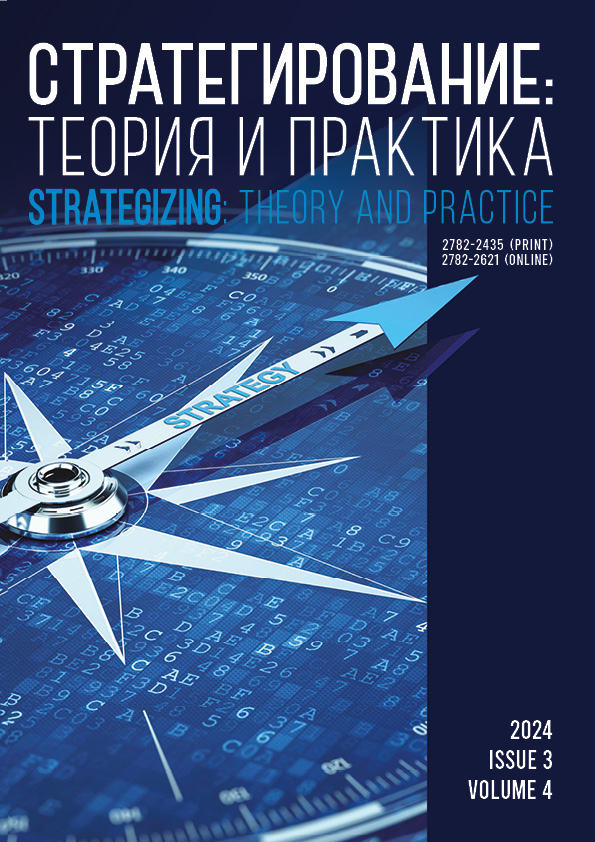Moscow, Russian Federation
Moscow, Russian Federation
The problem field of healthcare staffing is a highly relevant area for research efforts in strategizing. This study featured the human resource potential of the domestic healthcare system in a national and regional contexts. The theory and methodology of strategizing developed by Professor Vladimir L. Kvint made it possible to trace some indicators of human resourcing potential in the healthcare sector, i.e., age, regional structure, reproduction of labor-power, etc. Effective strategizing depends on the patterns that kept repeating since the beginning of the century. The research revealed the key principles of personnel strategizing in healthcare. First, constant high-quality monitoring helps to follow the changes in the patterns of reproduction of human resources, including regional specifics. Second, global trends in healthcare, e.g., digitalization, optimize the work and increase its efficiency. Third, personnel strategizing takes into account current and projected changes in morbidity, technological development, unexpected challenges like the COVID-19 pandemic, etc. Fourth, healthcare strategizing needs accounting, identification, instrumentalization, and institutionalization of factors that contribute to the growth of human resources. Fifth, strategizing in this sphere requires coordination with human resourcing in other industries, especially those connected with intellectual labor. Finally, attraction, retraining, and advanced training of foreign specialists and students are of great importance for effective strategizing.
healthcare, human resources potential, regions of Russia, personnel reproduction, patterns, strategizing
1. Bizin SV. Personnel management of the regional healthcare system. Leadership and Management. 2023;10(4):1419–1438. (In Russ.) https://doi.org/10.18334/lim.10.4.118953
2. Menshikova LI, Peletskaya KN, Ogryzko EV, Flegler NA. The age range of medical staff in the Russian federation (2015–2022). Current Problems of Health Care and Medical Statistics. 2022;4:507–523. (In Russ.) https://doi.org/10.24412/2312-2935-2022-4-507-523
3. Gersonskaya IV. The healthcare system in Russia: the main problems and possible ways to solve them. Bulletin of Chelyabinsk State University. 2023;3(473):53–63. (In Russ.)
4. Kvint VL. Global economic trends: analysis and perspectives. Economics and Management. 2012;3:4–6. (In Russ.)
5. Kvint VL. Globalʹnyy formiruyushchiysya rynok – vliyanie na strategiyu Rossii i strategicheskoe razvitie rossiyskikh kompaniy [Global emerging market and its impact on Russian strategy and strategic development of Russian companies]. Ehffektivnoe antikrizisnoe upravlenie [Effective Crisis Management]. 2012;72(3):50–61. (In Russ.)
6. Kvint VL. The idea of a noosphere of Vernadsky and the regularities predetermining formation of a global noosphere world order of the XXI century. Administrative Consulting. 2013;5(53):013–019. (In Russ.)
7. Kvint VL. On implementation of strategy and other long-term documents of strategic importance. Teoriya i praktika strategirovaniya (Seriya «Ekonomicheskaya i finansovaya strategiya») [Theory and practice of strategizing: Proceedings of the VII International Scientific and Practical Conference]. Kemerovo: KemSU; 2024. P. 35–39. (In Russ.)
8. Kvint VL, Novikova IV, Alimuradov MK. Alignment of global and national interest with regional strategic priorities. Economics and Management. 2021;27(11):900–909. (In Russ.) https://doi. org/10.35854/1998-1627-2021-11-900-909
9. Kudelina O, Killyakova E. The issues of management and development of human resources for healthcare. International experience. Human Ecology. 2018;8:17–27. (In Russ.) https://doi.org/10.33396/1728-0869-2018-8-17-26
10. Lebedeva IS, Lebedev PV. Trends in solving staff problems in health care. Bulletin of the Academy of Knowledge. 2022;48(1):151–159. (In Russ.) https://doi.org/10.24412/2304-6139-2022-48-1-151-159
11. Magomadova TL. On the implementation of the state personnel policy in the health care system: domestic and foreign experience. Herald of GSTOU. Humanitarian, social and economical sciences. 2022;18(4(30)):20–28. (In Russ.) https://doi.org/10.34708/GSTOU.2022.62.64.003
12. Makarov SV, Gaidarov GM. Kadrovaya politika v zdravookhranenii: sotsialnyy aspekt [Personnel policy in healthcare: social aspect]. Irkutsk: Irkutskiy gosudarstvennyy meditsinskiy universitet; 2022. 192 p. (In Russ.)
13. Morozova YuA. Strategic priorities for regional health development in the context of world and industry trends. Strategizing: Theory and Practice. 2022;2(1):147–162. (In Russ.) https://doi.org/10.21603/2782-2435-2022-2-1-147-162
14. Novikova IV. Strategizing of the human resources development: main elements and stages. Strategizing: Theory and Practice. 2021;1(1):57–65. (In Russ.) https://doi.org/10.21603/2782-2435-2021-1-1-57-65
15. Maev IV, Kupeeva IA, Son IM, Leonov SA, Gazheva AV. Demand of Russian Federation in medical human resources. Manager zdravoochranenia. 2013;10:6–11. (In Russ.)
16. Ulumbekova GE. Healthcare in Russia 2022–2023: emergency measures in the context of the special situation in economy and social sphere. Issues and proposals. Healthcare Management. News. Views. Education. 2022;8(2(28)): 4–21. (In Russ.) https://doi.org/10.33029/2411-8621-2022-8-2-4-21
17. Markhorst B, Zver T, Malbasic N, Dijkstra R, Otto D, van der Mei R, et al. A data-driven digital application to enhance the capacity planning of the covid-19 vaccination process. Vaccines. 2021;9(10):1181. https://doi.org/10.3390/vaccines9101181
18. Ahmed A, Hounsell KG, Sadiq T, Naguib M, Koswin K, Dharmawansa C, et. al. Eliminating malaria in conflict zones: Public health strategies developed in the Sri Lanka Civil War. BMJ Global Health. 2021;6(12):e007453. https://doi.org/10.1136/bmjgh-2021-007453
19. Lee D, Kim K. Public R&D projects-based investment and collaboration framework for an overarching South Korean national strategy of personalized medicine. International Journal of Environmental Research and Public Health. 2022;19(3):1291. https://doi.org/10.3390/ijerph19031291
20. Ramadevi D, Gunasekaran A, Roy M, Rai BK, Senthilkumar S. Human resource management in a healthcare environment: framework and case study. Industrial & Commercial Training. 2016;48(8):387–393. https://doi.org/10.1108/ICT-03-2016-0014
21. Santeramo FG, Tappi M, Lamonaca E. On the management of COVID-19 pandemic in Italy. Health Policy. 2021;125(8):995–1001. https://doi.org/10.1016/j.healthpol.2021.05.014
22. Boniol M, Kunjumen T, Nair TS, Siyam A, Campbell J, Diallo K. The global health workforce stock and distribution in 2020 and 2030: a threat to equity and “universal” health coverage? BMJ Global Health. 2022;7(6):009316. https://doi.org/10.1136/bmjgh-2022-009316
23. Marmo R, Pascale F, Sicignano E, Fiore P, Polverino F. The response of the Italian healthcare facilities to the COVID-19 pandemic: Analysis of national and regional legislation. Smart Innovation, Systems and Technologies. 2022;263:79–88. https://doi.org/10.1007/978-981-16-6269-0_7
24. Seitio-Kgokgwe OS, Gauld R, Hill PC, Barnett P. Understanding human resource management practices in Botswana's public health sector. Journal of Health Organization and Management. 2016;30(8):1284–1300. https://doi.org/10.1108/JHOM-05-2015-0076
25. Zhao S, Du J. Thirty-two years of development of human resource management in China: review and prospects. Human Resource Management Review. 2012;22(3):179–188. https://doi.org/10.1016/j.hrmr.2012.02.001






